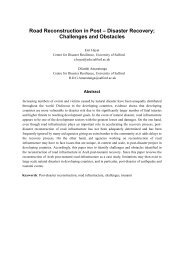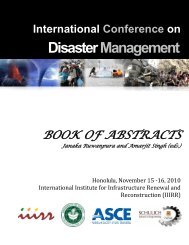Alternative resilient livelihood option for fisher-folks tsunami victims
Alternative resilient livelihood option for fisher-folks tsunami victims
Alternative resilient livelihood option for fisher-folks tsunami victims
Create successful ePaper yourself
Turn your PDF publications into a flip-book with our unique Google optimized e-Paper software.
will get much better prices. Exposure to the sun or heat during transport should be avoided to insure<br />
the freshness of the produce. During transport, it was not always possible to keep the seaweed wet<br />
and cool<br />
Siganus sp is the main grazers and they can literally wipe out Gracilaria culture (Coppen, 1990).<br />
However Siganus lineatus and Siganus javus severely grazed Gracilaria and reduced the net harvest.<br />
It appears that juvenile Siganus are largely to blame. The fish began entering the plots, as evidenced<br />
by grazed seaweed. During our farming period we observed that Siganus were less than 100 g, with<br />
the majority below 40 grams. Clearly, the seaweed farms were sited on the feeding grounds of the<br />
juveniles of the principal grazing species. Two methods were per<strong>for</strong>med to protect the Gracilaria<br />
from Siganus sp were tested in Paalameenmadu. First, a net enclosure was made around the farming<br />
area traps. They are placed inside fenced plots. The second method involves making scare lines<br />
made of pieces of Palmyrah leaves. However, Siganus sp swam over the scare line and into the farm<br />
plot and all the seaweed was eaten by Siganus sp. These scare lines were totally ineffective. But the<br />
net enclosure fence had to be buried in the sandy bottom to prevent it from lifting off the bottom by<br />
water current and prevent to allowing the entry of grazer. The fence effectively excluded Siganus sp<br />
at Paalamenmadu. A few entered under the fence, but could be controlled with traps. It revealed that<br />
more trials are to be conducted to find the alternative sites. Small unidentified mollusks were<br />
frequently observed on planted lines and could have grazed on the few plants which germinated.<br />
During the culture period spores are fell down to the bottom and grew as a new Gracilaria bed and<br />
attract more herbivorous fish like Mugil cephalus, and Siganus sp. This will stimulate fish stock to<br />
remain hidden. These grounds act as feeding and spawning ground to many fish in this way enhance<br />
fish stock as well as it could be maintain ecological balance and dynamics. Assessment of<br />
commercial feasibility requires both long-term trials and sufficient production capacity to evaluate<br />
economic and technical costs.<br />
The results from crab fattening indicated that the fattening of crabs is possible growth and survival<br />
can be achieved through proper management. In this experiment, the mean survival percentage was<br />
88% and mean mortality was 12%. The mortality was at an acceptable level and it was experienced<br />
at the initial stages of the fattening. These initial mortalities occurred during the first ten days could<br />
be due to a highly stressed new environment and poor handling during collection and transport. In<br />
crab fattening systems, mortality may also be caused by poor quality of water at the bottom of the<br />
mud. But in the floating cage system, this type of mortalities cannot be expected. Table 2 provides<br />
the data regarding the growth, survival, and production of crabs.

















